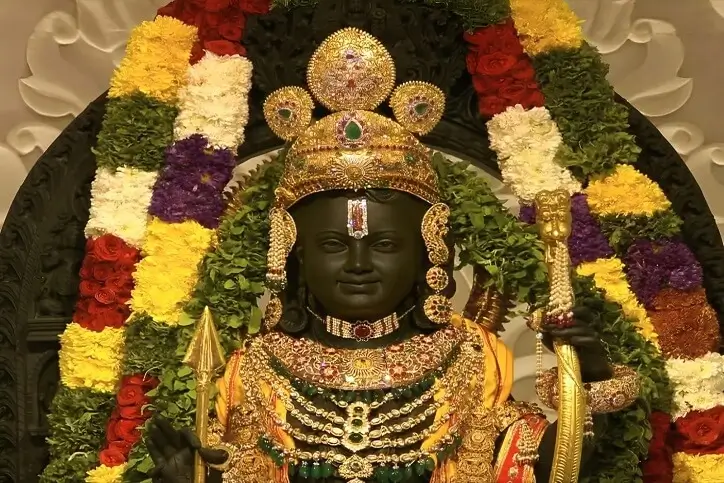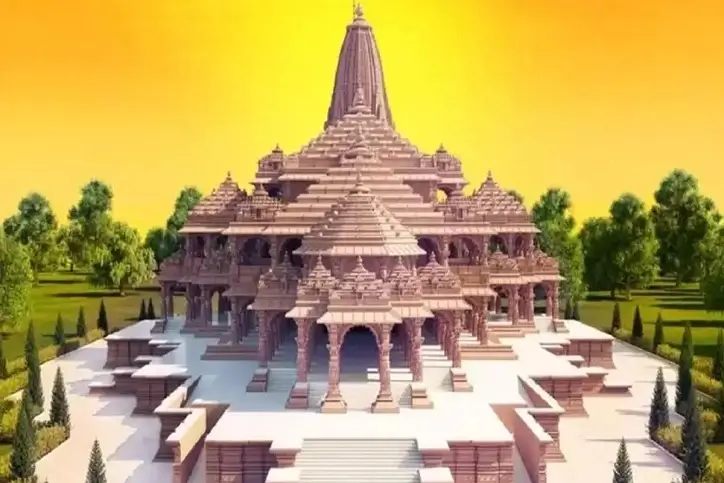The Ayodhya Ram Mandir isn’t just a temple; it holds a profound significance in India’s vibrant history. It’s not just for prayers. It shows Hindu traditions and faith. Ayodhya is important in Hinduism. It’s not just a city. It’s where people go to show their faith. Every year, millions visit. The Ram Mandir Ayodhya makes Ayodhya more than just a place. It’s where India’s past meets today.
This temple is also a cultural landmark. It has shaped how people in India think and talk about culture and religion. The Ayodhya Ram Mandir isn’t just for one religion. It’s a symbol for everyone in India. The temple is linked to the Ramayana. This ancient story tells about Lord Rama. People believe he was born where the temple is. The Ramayana is not just a story. It teaches about good, duty, and doing the right thing. The temple helps Ayodhya’s economy.
The Ram Mandir is a key part of India’s history. It’s connected to the Ramayana. It’s more than a religious spot. It’s part of what makes India unique. The temple is a must-see for Ayodhya Ram Mandir tours and custom tours. It’s about exploring India’s spiritual and cultural sides.
The Mythological Roots of Ayodhya Ram Mandir
The Ayodhya Ram Mandir, deeply connected with the intricate mythology of the Ramayana, stands as a crucial site in India. More than just an architectural wonder, this temple embodies the lasting influence of the epic narrative. The Ramayana, a fundamental text for many, narrates the virtuous journey of Lord Rama. Recognized as the sacred birthplace of Rama, the temple holds profound spiritual significance for believers.
The Ramayana’s impact on Indian culture and the Ram Mandir is vast. It shapes morals and social norms, making the temple a symbol of the Ramayana’s virtues – duty, bravery, and good triumphing over evil. This link turns the temple from a mere building into a sacred place reflecting the epic’s teachings.
Visiting the temple is a journey through the Ramayana’s pages. Its walls echo Lord Rama’s story, making it crucial for customized tours. It’s a place where history and mythology converge, providing a unique experience.
Lord Rama’s birth in Ayodhya holds paramount importance in Hinduism. As the incarnation of Vishnu, his narrative is central to Hindu traditions. Celebrated widely, especially at the Ayodhya Ram Mandir, his birth is a spiritual landmark.
Rama’s significance in Hinduism is profound. He embodies dharma (righteousness) and moral integrity. His life’s challenges and victories guide Hindus. His principles – duty, family respect, and justice – are core to Hindu philosophy.
The Ayodhya Ram Mandir, marking Rama’s birthplace, underscores these teachings. It transcends being just a temple; it symbolizes Rama’s virtues. It’s key in the Golden Triangle Tour with Varanasi, attracting diverse visitors to connect with Hindu mythology. The temple is where the divine meets the earthly, blending spiritual and historical aspects.
In summary, the Ayodhya Ram Mandir, deeply rooted in the Ramayana and linked to Lord Rama’s birth, holds profound spiritual and cultural significance. It serves as a testimony to the enduring impact of the Ramayana and Lord Rama on Hinduism. Whether through customized tours, a visit offers deep insight into Hindu tradition.
Ayodhya: The Sacred City
In the Ramayana, Ayodhya is the ideal city, embodying peace and wealth. Its streets, with gardens and palaces, were filled with happiness. The city, radiant with Lord Rama’s presence, symbolized dharma and moral excellence. This portrayal makes Ayodhya a celestial place, blending divine and earthly realms.
Ayodhya’s cultural influence is seen in arts inspired by its mythology. Artists here depict the Ramayana and Lord Rama, preserving these stories. This artistic legacy adds to Ayodhya’s appeal as a cultural destination.
The city, as described in the scriptures, invites visitors to immerse themselves in its sacred atmosphere, making it one of the best tourist destinations in India for spiritual seekers and history enthusiasts alike.
Ayodhya’s architecture, especially the Ayodhya Ram Mandir, reflects its spiritual history. This temple, a symbol of devotion, attracts global visitors, making it key for customized tours in India.
In conclusion, Ayodhya’s scriptural portrayal and cultural role highlight India’s heritage. Connected to the Ramayana and Lord Rama, it’s a beacon of spirituality and culture. From ancient stories to the Ram Mandir Temple Ayodhya, the city offers a profound experience, making it a must-visit in India.
The Janmabhoomi and the Babri Mosque: A Historical Overview
The Janmabhoomi site in Ayodhya holds immense significance and is believed by many to be the birthplace of Lord Rama. This makes it a special place for many people. It’s more than just a spot; it symbolizes deep faith in Hindu culture.
For a long time, Janmabhoomi has been important for religious events. People from all over the world come to Ayodhya for this. They come to feel a connection with history and spirituality. The story of Lord Rama and his Ram Rajya rule is very important here.
Janmabhoomi is also known for its rich history and culture. It’s a place where past stories come alive. For those on custom tours in India, it’s a must-see. It shows the heart of Hindu beliefs.
The Babri Mosque at Janmabhoomi carries its own narrative. Constructed in the 16th century, it held significant importance in Islamic history, standing as a part of Ayodhya’s historical fabric for centuries.
The mosque’s story is linked with India’s history. It was important for both Hindus and Muslims. This made Ayodhya a special but complex place. The mosque was a big part of this history.
In 1992, the Babri Mosque was taken down. This was a big moment in India. It led to many talks about faith and history. Now, the place still brings up strong feelings. It’s an important stop for people visiting India to understand its diverse culture.
The Ram Mandir in Ayodhya is being built at this same place. It starts a new chapter for Ayodhya. Many hope it will be a time of peace and togetherness.
As Ayodhya continues to evolve, it remains a key destination for those seeking to explore the depths of India’s cultural and spiritual legacy, offering essential tips for travel in India and a unique perspective on its diverse history.
The Ram Janmabhoomi Movement: A Modern Perspective
The Ram Janmabhoomi movement holds a significant place in recent Indian history, emerging as an effort to construct the Ayodhya Ram Mandir at the believed birthplace of Lord Rama. This movement, rooted in religious and cultural feelings, became a major force, changing India’s politics and society.
It began in the early 1980s when Hindus felt a strong religious identity. The movement grew with groups supporting the Ram Mandir. They wanted a grand temple at the site of the Babri Mosque, believed to be over Lord Rama’s ancient temple.
As the movement grew, it got support from many. It became a symbol of Hindu revival, mixing religion with national identity. It was driven by religious passion, cultural pride, and history. This made it a big part of Ayodhya’s story and popular in Ayodhya tour packages.
Important events and people marked the movement. The Rath Yatra in 1990 was key. It brought national attention to the Ram Mandir issue.
Leaders, religious figures, and activists were central to the movement. They organized rallies and spoke for many Hindus. Their roles made the movement more than a religious campaign. It became a major socio-political force.
The movement’s high point was the 2019 Supreme Court verdict allowing the Ram Mandir’s construction. This was seen as a big win for its supporters.
In conclusion, the Ram Janmabhoomi movement is complex and important in modern India. It shows the ties between religion, politics, and cultural identity. For travel destinations in North India, especially those on customized tour packages, Ayodhya offers a chance to see this movement’s historical and cultural sides.
The Turning Point: Demolition of the Babri Mosque
The demolition’s roots go back to the growing movement for the Ram Mandir. Gaining strength in the 1980s and early 1990s, this movement was driven by Hindu nationalism. Many sought to construct the Ram Mandir at the mosque’s location, believed to be Lord Rama’s birthplace. The campaign saw rallies and gatherings, often led by key leaders.
Ayodhya’s atmosphere got tense as the movement grew. A large group gathered at the site, and despite efforts to keep peace, the mosque was demolished. This act was more than just destroying a building; it had a deep impact across India.
The demolition affected Indian society and Hindu-Muslim relations. It led to riots and violence, one of India’s darkest times. It worsened religious tensions, causing loss of life and deepening divides.
This event also changed India’s politics. It made secularism and religious freedom major topics. Political parties and leaders had to rethink their positions.
After the demolition, there were efforts to heal Hindu-Muslim relations. The incident led to discussions on peaceful coexistence and respect among religions.
The Ayodhya Ram Mandir remained important in this context. The site and its history became crucial for Ayodhya Ram Mandir tours and tailor-made tour packages in India. The story of the mosque’s demolition is key to understanding Indian society.
In conclusion, the Babri Mosque demolition was a turning point in India. For travelers with the best tour agency in India, visiting the Ayodhya Ram Mandir and the mosque’s site offers insight into India’s recent past. These places remind us of the challenges in India’s diverse society.
Legal Battles and the Supreme Court Verdict
The Ayodhya Ram Mandir has been central to a long legal battle. This dispute, involving religious groups, locals, and the government, is one of India’s most complex cases.
The legal fight started in the late 20th century, though the issue is older. It’s about who owns the land where the Babri Mosque was and Lord Rama’s believed birthplace. Different groups claimed the site, leading to many court cases.
These cases went through various courts, including the Supreme Court of India. They involved historical records, archaeological evidence, religious texts, and constitutional law. The legal process involved numerous hearings, petitions, and appeals, reflecting its intricacy.
The Supreme Court’s November 2019 verdict marked a pivotal moment. It permitted the construction of the Ram Mandir at the disputed site and directed the allocation of land for a mosque elsewhere.
The decision considered archaeological findings, history, and legal principles. The Court aimed for a fair solution for both Hindus and Muslims. This verdict was important for secularism and religious harmony in India. It was seen as upholding the law, justice, equity, and tolerance.
This ruling led to the Ram Mandir’s construction. It’s now a key spot for Uttar Pradesh tour packages and India private tours. It’s also part of the best Golden Triangle India, showing India’s cultural, legal, and social complexity.
In conclusion, the legal battles surrounding the Ayodhya Ram Mandir and the subsequent Supreme Court decision are integral to India’s history. They show the country’s respect for law and diverse religions. For visitors to Ayodhya, through Uttar Pradesh tour packages, India private tours, or the best golden triangle packages, the site offers a spiritual experience and a view of India’s journey to religious harmony and legal resolution. The Ayodhya Ram Mandir’s story is key to understanding India’s complex society.
The Formation of Shri Ram Janmabhoomi Teerth Kshetra
The formation of the Shri Ram Janmabhoomi Teerth Kshetra Trust followed the 2019 Supreme Court verdict. Its role is big. It manages funding, legal standards, and the temple’s building. The trust ensures the site’s sanctity and makes it a pilgrimage spot.
The trust also works with local communities, religious groups, and the government. It coordinates infrastructure around the temple for pilgrims. Its tasks are wide-ranging, all aimed at making the Ayodhya Ram Mandir a faith and heritage center.
Since its start, the trust has taken big steps towards building the temple. It ran a national fundraising campaign, showing the temple’s importance to many. For construction, it hired top architects and engineers. The temple design follows Vedic principles and uses traditional methods, reflecting India’s architectural heritage.
The trust also focuses on environmental sustainability. It aims to minimize construction’s impact on Ayodhya’s environment. For visitors, the trust arranges group tours and packages. It works with travel agencies and car rental services in India for a good experience for pilgrims and tourists. The trust’s work covers everything from design to visitor management.
In conclusion, the trust’s formation and actions are important in the Ayodhya Ram Mandir’s story. It blends spiritual commitment, cultural preservation, and modern management. For visitors, through group tours or individual trips, the temple is where ancient heritage meets modern devotion. The trust’s efforts make the Ayodhya Ram Mandir a worship place and a symbol of India’s cultural and spiritual legacy. It’s accessible through group tour packages and services like car rental in India.

The Cultural and Religious Significance of the Temple
The Ayodhya Ram Mandir is more than an architectural wonder; it deeply symbolizes Hindu faith and identity. Building this temple is about reviving a heritage central to the Hindu mindset. Dedicated to Lord Rama, a key figure in Hinduism, the temple links directly to the Ramayana, shaping India’s religious and cultural landscape for centuries.
For Hindus worldwide, the Ram Mandir goes beyond the physical. It embodies their beliefs, values, and the core of their religion. The temple is a key place for Hindu worship, where the divine and human worlds meet. It’s where devotees find spiritual peace and connect with the divine.
The temple also represents Hindu identity. In a diverse country like India, where religion is vital, the Ayodhya Ram Mandir is a testament to Hindu heritage. It symbolizes the endurance of Hindu culture and its traditions over time.
The temple’s cultural and religious importance affects Indian culture and heritage broadly. It’s a beacon of India’s rich history and spiritual traditions. Building the temple marks a return to traditional architecture and ancient craftsmanship. Artisans from across India are creating an artistic and sacred structure. This mix of art and spirituality makes the temple a living showcase of Indian culture.
Moreover, the Ram Mandir contributes to the story of Indian secularism and pluralism. It stands in a land of diverse religions. So, the temple is more than a Hindu shrine; it symbolizes India’s balance between religious respect and secular values.
For travelers on a golden triangle tour in India, visiting the Ayodhya Ram Mandir is a chance to see where faith, history, and culture merge. It offers a view into India’s spiritual depth, artistic heritage, and pluralistic nature.
Conclusion
The Ayodhya Ram Mandir’s journey intertwines faith, history, and cultural identity. More than just a structure, it symbolizes devotion and a civilization’s resilience. From its roots in the Ramayana to its recent reconstruction, the temple’s story mirrors India’s – rich and diverse, filled with perseverance.
The construction, facing challenges, shows the will of millions to see their faith and heritage in stone and art. It symbolizes hope and belief in triumphing over adversity. The Ayodhya Ram Mandir isn’t just for pilgrims; it’s a beacon for cultural and spiritual exploration, welcoming all to witness an ancient civilization’s living legacy.
In today’s Indian society, the temple serves multiple roles. It’s a spiritual haven, a national monument, and a hub for cultural tourism. It goes beyond religion, inviting everyone to appreciate its architecture and story.
The temple also promotes communal harmony and cultural understanding. In diverse India, it reminds us of the ties between communities – respect for tradition, spiritual pursuit, and celebrating heritage.
For travelers, especially on a luxury Golden Triangle tour in India, the temple offers an enlightening and enriching experience. It lets you delve into India’s spiritual heart, witnessing ancient traditions and modern dreams.
As we reflect on the Ayodhya Ram Mandir‘s journey and role, we invite you to experience it. Whether you’re a spiritual seeker, history lover, or cultural enthusiast, it’s a must-see. Plan your visit now with Custom Tours India. Join a tour in India and let the temple be a highlight. Witness its grandeur, feel its spirituality, and immerse in India’s culture. Book your journey today and step into a timeless story.
FAQs
What is the Historical Significance of Ayodhya Ram Mandir?
The Ayodhya Ram Mandir is believed to be Lord Rama’s birthplace, a key figure in Hindu mythology and the Ramayana. Ayodhya, the temple’s location, is one of Hinduism’s seven key pilgrimage sites. The temple symbolizes the heritage of ancient Indian civilization. Its reconstruction revives a crucial part of India’s cultural and religious history.
How Did the Ram Janmabhoomi Movement Start?
This movement began in the 1980s, aiming to build a temple at Lord Rama’s believed birthplace in Ayodhya. Driven by the desire to correct historical injustices, it gained momentum with Hindu nationalist organizations and political parties, leading to national rallies and public events.
What Was the Supreme Court’s Verdict on the Ayodhya Dispute?
In November 2019, India’s Supreme Court ruled to hand over the land where the Babri Mosque stood for the Ayodhya Ram Mandir construction. The Court also ordered land allocation in Ayodhya for a new mosque, aiming for a balanced resolution to the long-standing conflict.
What Challenges Did the Construction of the Temple Face?
The temple’s construction faced legal disputes, logistical issues, and the need to maintain communal harmony. The COVID-19 pandemic added delays and necessitated health protocols on-site.
How Does the Ayodhya Ram Mandir Impact Hindu-Muslim Relations in India?
The temple has been a contentious point between Hindu and Muslim communities. The Supreme Court’s verdict and the temple’s peaceful construction start as steps toward communal harmony. This development is hoped to foster mutual respect and understanding between the communities.
How Has the Ayodhya Ram Mandir Influenced Indian Culture and Heritage?
The temple has significantly impacted Indian culture and heritage. It has renewed interest in India’s history, arts, and architecture. As a symbol of India’s cultural and spiritual traditions, its reconstruction has reignited pride in Indian heritage.



